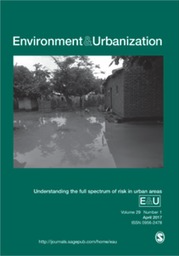
This issue of Environment and Urbanization is on the full spectrum of risk in urban areas of the global South and their contribution to premature death, serious injury, illness or impoverishment. The papers show the large spectrum of risks from infectious and parasitic diseases, pollution and physical hazards. “Small” disasters and every-day hazards that often receive less attention than disasters actually pose greater risks, especially among low-income groups and those living in informal settlements. City-specific studies in this issue explore the nature and measurement of local risks, in Karonga, Malawi; Niamey, Niger; Bandung, Indonesia; Bangkok, Thailand; and Nairobi, Kenya. The issue also includes papers that interrogate the concept of risk resilience, calling for greater attention to rights, justice, and concrete community-led action. The papers propose new directions for classifying and collecting information on risks, which is the first step towards reducing risks for the most vulnerable urban residents. Several of these papers emerged from Urban Africa: Risk Knowledge (Urban ARK), a research and capacity-building programme seeking to reduce risk in urban areas of sub-Saharan Africa.
Two papers examine livelihood issues: one is on the livelihood impacts of the Arab Spring; the other is on a janitorial job programme in Cape Town that sought to combine livelihoods with toilet maintenance. Other papers propose frameworks for understanding current urban conditions: household energy needs in Thai cities, and micro-inequalities more generally. And several papers look to the future. One outlines what is needed for genuine gender transformation in a global urban agenda, while another explores the potential of self-financing urban development to reduce inequality and increase local involvement in urban policy. Two papers provide alternative predictions of which cities are likely to be the largest in the next century.
Links
Resource collections
- UN Habitat - Urban Response Collection
- Urban Response - Urban Crisis Preparedness and Risk Reduction
- Urban Response Collection - Community Engagement and Social Cohesion
- Urban Response Collection - Economic Recovery
- Urban Response Collection - Environment and Climate Change
- Urban Response Collection - Housing, Land and Property
- Urban Response Collection - Urban Crisis Response, Recovery and Reconstruction
- Urban Response Collection - Urban Resilience